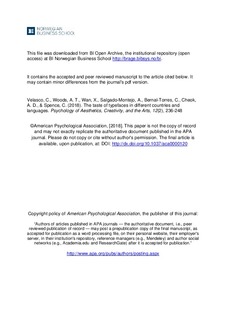The taste of typefaces in different countries and languages
Velasco, Carlos; Woods, Andy T.; Wan, Xiaoang; Salgado-Montejo, Alejandro; Bernal-Torres, Cesar; Cheok, Adrian David; Spence, Charles
Journal article, Peer reviewed
Accepted version
Permanent lenke
http://hdl.handle.net/11250/2499581Utgivelsesdato
2018Metadata
Vis full innførselSamlinger
- Publikasjoner fra CRIStin - BI [1015]
- Scientific articles [2181]
Originalversjon
Psychology of Aesthetics, Creativity, and the Arts, 2018, 12(2), 236-248 10.1037/aca0000120Sammendrag
People associate tastes and taste words (e.g., “bitter,” “sweet,” etc.) with shape features in predictable ways. In the present study, we evaluate how the curvature and boldness of typeface influences the gustatory taste (i.e., bitter, salty, sour, and sweet) associated with the typefaces of words written in 3 languages (Spanish, English, and Chinese). The study also included participants from 3 countries: Colombia, the United Kingdom, and China. Consistent with previous research, rounder typefaces were reliably associated with the word sweet, whereas more angular typefaces were associated with the other tastes in all 3 languages and countries. These results provide robust support for the notion that shape curvature is differentially matched to tastes, in a manner that is similar, across countries. Moreover, the results also indicate that all of the participants evaluated the angular typefaces in Spanish and English as more bitter, salty, and sour than the round typefaces in Spanish and English, but this angular/rounded effect was not found with Chinese typefaces. Additionally, the rounder typefaces were evaluated as sweeter than the angular typefaces in all languages and countries. Given that the Chinese round and angular characters differed only in terms of the perceived curvature (not liking, familiarity, and clarity), it is not possible to conclude that liking accounts for all the correspondences that we report. Possible mechanisms and directions for future research are discussed
